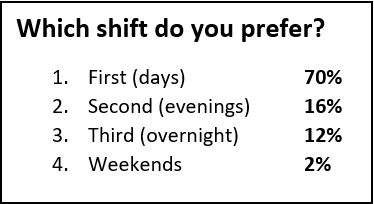 Two years into the pandemic, the way nearly all workers think about the social contract with their employers has changed in profound ways. For the hourly wage earners who power the economy, the desire for a flexible schedule and preferred shift is now more important than ever.
Two years into the pandemic, the way nearly all workers think about the social contract with their employers has changed in profound ways. For the hourly wage earners who power the economy, the desire for a flexible schedule and preferred shift is now more important than ever.
Focus on Flexibility
It was one of the most striking findings in the 2022 Voice of the Blue-Collar Worker (VBCW) survey, which was completed by nearly 19,500 participants across the US. While shift and schedule flexibility have been important in the past, they have now become one of the top three factors in a worker’s decisions about both the job they choose and whether or not to stay at the job.
Further, when asked to reflect on what had driven them to take jobs in the past, 21% of workers cited scheduling as the most important factor, even ranking it higher than a pay increase (which was the No. 2 factor).
Factors to Drive Loyalty and Resilience
Perhaps the uncertainty of pandemic demands — never knowing when schools might send children home to quarantine or a loved one could need medical care, for example — were factors in this appreciation of flexibility. Perhaps the demands on essential workers over the past year made clearer the importance of spending time on what one values most. Flexible schedules support these choices and in turn can strengthen morale and worker loyalty.
When asked what employers could do to earn workers’ loyalty, 15% of respondents chose flexible work schedule while 20% indicated advancement opportunity. Another 10% selected “understand I have obligations outside work,” a perspective that supports the need for flexibility.
Interestingly, understanding employee obligations beyond work was also important to 2021 participants (11%), while “flexible schedule” was not yet among the top five factors last year. So, this groundswell toward schedules that work for workers may have been building over time.
PREMIUM CONTENT: Workforce Solutions Buyer Survey: 2022 Americas Results
Female Workers’ Priorities
When seeking a job, the top priorities for all workers together are pay rate (39%), job security (12%), shifts/schedules (11%) and enjoyment of the work (9%).
However, when looking at priorities by gender, the VBCW survey found that scheduling was the second-most important factor for women, while for men, it ranked fourth. Female workers also expressed more interest in different shift schedules like flex and gig than their male counterparts.
The value that female workers place on schedules came up again in the survey’s shift differential increase section. The average amount women said they would need to change from a first shift and stay on that shift was seven cents an hour higher than men — a small but noteworthy difference.
Second and Third Shift Incentives Needed
Overall, blue-collar workers today have a strong preference for first-shift work.
Not everyone can work first shift. For many essential industries, 24-hour operations need to be staffed. How can employers fill roles for what workers increasingly see as much less desirable shifts?
Each year, the VBCW survey explores the shift differential, asking workers how much more per hour they would require not only to move to a later shift but to stay at it. While pre-pandemic, this minimum raise changed little (it was $1.26 in 2016 and still just $1.33 in 2020), the past years have seen significant spikes. In 2021, it jumped to $1.48, while 2022 brought an even more dramatic uptick to $2.03 an hour more.
For employers to staff other shifts, higher pay is clearly the most valued incentive. But it’s not the only one!
Flexible Thinking Costs Nothing
In 2022, flexibility and shift choices matter more than ever, and often these elements can be part of an attractive work experience that doesn’t cost more. Competitive employers are exploring non-monetary incentives such as offering predictable hours, letting workers choose their shifts or rotations, eliminating mandatory overtime and building in unique flexibility options that work for their individual scenarios and workers.
For more insights on shifts, schedules and other key factors in recruiting and keeping a quality workforce, download the full 2022 Voice of the Blue-Collar Worker report.
